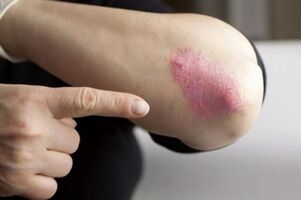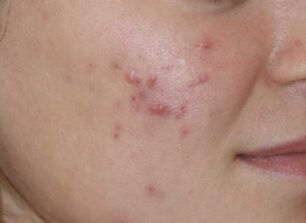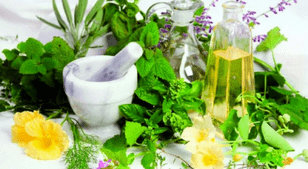In this article, we consider the early stage of psoriasis, its etiology and the mechanism of formation of damaged parts. By following our recommendations, you can recognize the symptoms of psoriasis at an early stage and eliminate them.
Early signs of psoriasis
Patients may have different initial signs of psoriasis. This disease is characterized by an acute attack and a short rash. Primary rash is also called work rash or guard rash.
The initial phase lasts several weeks. The duration of the disease at this stage depends on the general condition of the body and its protective capacity.
The rash consists of small pimples (papules) ranging from light pink to red, towering over the skin. They feel thick to the touch.
After a while, you will find silvery white scales that are easy to remove. The skin of the affected area is inflamed, swollen, and red.
Experts have determined 3 characteristics that distinguish psoriasis from other diseases:
| Function | Features |
| Stearin staining. | This is a patch, and small scales will appear when scratched. |
| Psoriasis movies. | The last layer that can be removed from the skin after removing the scales. This layer is similar to plastic wrap. |
| Blood show or Auspitz phenomenon. | The appearance of blood drops violates the integrity of the psoriasis membrane. |
Eyelashes have different shapes: point, drop, coin, ring, scattered.
In addition to the rash, the patient is also worried about peeling, redness, and itching of varying intensity.
Elbow Psoriasis

Plaque psoriasis is a characteristic of the elbow area. First, a single red papule appears. Then the skin began to peel and rough.
Psoriasis on the legs
First signs: small rash, skin inflammation and swelling. Typical positioning: knees and feet. Over time, the skin peels off and the disease begins to develop.
Psoriasis on the hands
The first papules appear on the extensor parts of the joints (in the area of the fingers and elbows). The rash often appears on the palms along with foot lesions. Psoriatic arthritis sometimes occurs. It affects joints of various sizes. It is characterized by joint swelling, redness and deformation, and painful sensations may interfere.
Psoriasis on the nails
The manifestation of the disease on the nail plate looks like a fungal infection. First, there are longitudinal grooves and depressions along the edge of the nail. Over time, the process gradually approaches the root area of the nail. The nails become dull and thick. As the disease progresses, nails may fall off.
Head psoriasis
Location of rash: frontal lobe, behind ears and neck. Pimple rash is accompanied by scaling and itching. The damaged area is usually wet and cracked. The typical symptom is "psoriasis crown". A rash occurs when it exceeds the growth range of the hair.
Psoriasis on the face
This disease rarely affects the front of the head. Location of the rash: the eyelids, nasolabial folds, around the eyes, eyebrows, fine mesh on the cheeks.

Characteristics of early psoriasis in children
To determine whether a child has psoriasis, the first thing to look for is the redness between the skin folds and the small pimples (acne) that rubbed against clothes and irritants. The child becomes restless due to itching and burning.
Need to know! In infants who do not need to be examined, the early stages of psoriasis may be mistaken for allergic manifestations, high quality, rickets, and diaper dermatitis. A distinctive feature of psoriasis is clear boundaries.
It should be pointed out that congenital psoriasis in children is characterized by more obvious clinical manifestations from birth.
Children with weakened immunity following a severe infection are at risk of psoriasis. Special attention should be paid to children whose parents have psoriasis.
The formation mechanism of psoriasis plaque
Psoriasis spots are areas where inflammation occurs and keratinocytes (epithelial cells) are over-formed. In this case, too many capillaries are formed in the dermis. Infiltration (soaking) of damaged skin by lymphocytes and macrophages causes it to thicken and rise. As a result, light gray spots that look like hardened wax are formed.Important! Usually, the epidermis is renewed every 30 days. For psoriasis, the duration of the process is significantly reduced. This disease requires only 5 days for cells to divide, mature and die. Due to the pathological speed, communication between cells is lost.
Cause of occurrence
Experts have identified several annoying factors:
- Genetic predisposition.It is speculated that a genetic malfunction occurs in humans, leading to increased keratinization.
- Interruption of the immune system,leads to increased production of lymphocytes (T cells) and inflammation. Autoimmune response is not excluded-own cells and tissues are damaged by foreign bodies.
- Endocrine pathology,metabolic abnormalities.
- Nervous system diseases.
- Excessive psychological and emotional pressure, stress.This factor is a booster for the development of this disease, and it also exacerbates the onset of this disease. Under stress conditions, the body releases hormones and many biochemical reactions, leading to rashes and scales.
- drinking,drugs, smoking tobacco products.
Need to know!Children whose parents have psoriasis have an increased risk of this disease.
Disease diagnosis
If you suspect that you have psoriasis, please consult a dermatologist. Usually, after an external inspection and assessment of the condition of the damaged skin area, he will make a diagnosis. In rare cases, if there are diagnostic questions and difficulties, the doctor will list other research methods. These include:
- Skin Biopsy-The process of extracting damaged skin. Help identify changes in cellular level.
- Blood test.Help identify the presence of inflammation and rule out other diseases.
- X-ray of joints.It is specifically used for joint pain to rule out the development of psoriatic arthritis.
- Pharyngeal bacterial culture. It is prescribed to confirm that psoriasis is drip-shaped and to rule out acute pharyngitis.
- Potassium hydroxide test.Help eliminate fungal infections.
Disease treatment
Unfortunately, there is no cure for this disease today. Therefore, the main goal of treatment is to eliminate symptoms and relieve recurrence, while increasing the remission time (the time interval between the weakening and disappearance of disease symptoms). Therefore, treatment should be comprehensive and long-term.
After diagnosis, determine the stage and severity of the disease, and the dermatologist chooses the necessary treatment. Before starting treatment, the patient's diet and lifestyle should be adjusted. All possible factors leading to the deterioration of the disease were excluded.
In the initial stage, the doctor may prescribe the following:
| drug group | Drug name | Expected efficacy and characteristics. |
| Cuticle separating agent | Betamethasone. | Improve keratin. |
| Vitamins | Vitamin D3 or A derivative. | Improve the general condition of the body and skin. |
| Local non-hormonal preparations with anti-inflammatory effects | Carmustine hydrochloride, promethazine. | Eliminate inflammation, redness and swelling. |
| Tar Ointment | Coal tar extract | Improve healing effect. |
| Substances containing sterols | Has a positive effect on healing and can eliminate itching. | |
| Salicylic acid ointment | Salicylic acid | Speed up healing and promote cruc. |
In the initial stage, do not use aggressive drugs. The drug should be used externally, and if the condition is severe, the doctor will prescribe it orally.
In addition to medication, experts also prescribe physical therapy procedures:
- UFO (ultraviolet radiation).
- Body wash: paraffin, ra, sulfide.
- Sham therapy.
Traditional treatment methods
At home, you can use folk recipes for treatment. It should only be used in conjunction with the main treatment prescribed by a dermatologist, and only after consulting a doctor.
There are many recipes designed to improve the general condition of the body, as well as topical drugs used to eliminate the external manifestations of diseases. String, linseed oil, celandine, calendula ointment all have good effects.

Consider the most popular alternative treatment:
Psoriasis ointment
Ingredients:
- St. John's Wort-20
- Celandine (rooted grass)-20 grams
- Propolis-20 grams.
- Calendula-10 years
- Vegetable oil-10 grams
How to cook:Mash all the plants until smooth. Then add vegetable oil and mix well. Store in a cool place.
How to use:Lubricate the affected skin 2-3 times a day.
Results:Herbal ointment will help eliminate inflammation.
Egg ointment
Ingredients:
- 2 eggs
- Sunflower seed oil-1 tablespoon
- Acetic acid-40 grams
Cooking method:Stir the eggs and butter. Then acetic acid was added to the resulting material and mixed thoroughly.
How to use:Lubricate the affected skin every night and night.
Results:Effective treatments can eliminate the initial signs of psoriasis-reduce swelling, redness, and help fade the rash.
Herbal Soup
Ingredients:
- Seabuckthorn-10 years
- Tansy flower-10 grams
- Chamomile flower-15 grams
- Vodka-50g
- Sea buckthorn oil-10 grams
- Water-1 cup.
Cooking method:Chop all the plants. Then pour in boiling water and boil for 5 minutes. After that, the broth was poured for 40 minutes. Then filter, add vodka, sea buckthorn oil and stir well.
How to use:Put the broth into it once a day. To do this, dilute the product-3 drops per 0. 3 cup of warm water. Thin soup-1 tablespoon l Rub the same amount of water on the damaged skin once a day.
Results:The broth can be taken orally to eliminate the rash and inflammation-it has a general strengthening effect on the body.
Diet
Proper nutrition is the key to your health. Appropriate choice of diet helps prevent the deterioration of psoriasis. Prepare a meal for each patient.
Make sure to exclude from the diet:
- Tobacco and alcohol.
- Coffee.
- Chocolate.
- Smoked meat and spicy food.
- Preservatives and carbonated drinks.
In addition, the use of flour products and candies is restricted.
Your food should be complete and meet your energy needs. Nutritionists recommend the following foods in your diet:
- Fermented dairy products.
- Vegetable oil.
- Fresh vegetables and fruits.
- Congee.
Q&A
Which solid oil is used for psoriasis?
For this, a medicinal sterol is needed, which can be sold in drugstores. This reagent is most effective in its pure form without any additives.
Can psoriasis be treated with traditional medicine?
It is feasible, but it can only be used in combination with traditional methods and should be done after consulting a doctor. The salt bath works well (using sea salt). They help eliminate the inflammation of chamomile or string bath. The itching will help eliminate the infusion of juniper. In the initial stage, wiping with oatmeal will help eliminate flaking.
Is psoriasis contagious?
The answer is no: psoriasis is not contagious. The source of the disease has been completely refuted.
Is the psoriasis hair loss?
If psoriasis is not combined with other diseases that cause hair loss, this will not happen. In most patients, no hair loss is observed.
What makes psoriasis worse?
This disease has periods of improvement and deterioration. Understanding the factors that aggravate the condition will increase the time you are not troubled by its performance. There are few possible reasons for deterioration, so it should be considered and remembered:
- Skin injuries and scratches.A very common symptom of psoriasis is itching and burning. Grooming the damaged area will exacerbate this situation.
- Sunlight.Exposure to the sun rays of medium skin is beneficial. But at the same time, tanning can trigger the development of psoriasis.
- Stress.Some patients pointed out that the performance of psoriasis worsens after nervousness.
- Various infections.They destroy the body’s defense system and make it vulnerable.
- Eating.A healthy and correct diet is essential to the treatment of this disease. But if it is violated, the patient will notice that the condition deteriorates. Especially when you drink and smoke, there is no limit to the amount of tobacco.
Can I remove the flakes myself?
Impossible! You cannot delete the scale yourself. This can cause aggravation and discomfort.
Things to remember
- Psoriasis is a chronic disease that will improve and worsen over time.
- There is currently no cure for this disease. Treatment involves relieving symptoms and increasing the period of remission (when psoriasis symptoms do not appear).
- It is best to treat the initial stage of the disease, so if you experience initial symptoms, please consult a dermatologist.
- Children whose parents have psoriasis are more likely to get this disease.























